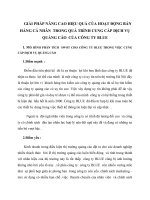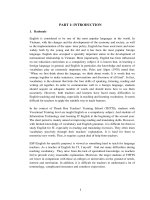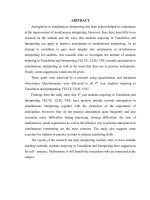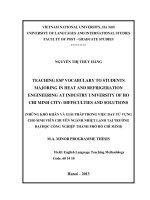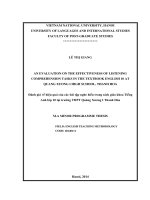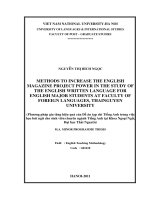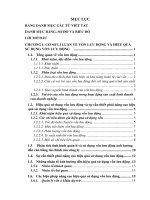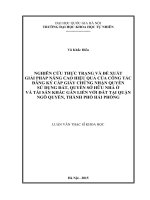Phương pháp gia tăng hiệu quả của Đề án tạp chí tiếng Anh trong việc học bút ngữ cho sinh viên chuyên ngành tiếng Anh tại Khoa Ngoại ngữ - Đại học Thái Nguyê
Bạn đang xem bản rút gọn của tài liệu. Xem và tải ngay bản đầy đủ của tài liệu tại đây (832.6 KB, 62 trang )
VIET NAM NATIONAL UNIVERSITY-HA NOI
UNIVERSITY OF LANGUAGES & INTERNATIONAL STUDIES
FACULTY OF POST GRADUATE STUDIES
*****************
METHODS TO INCREASE THE ENGLISH
MAGAZINE PROJECT POWER IN THE STUDY OF
THE ENGLISH WRITTEN LANGUAGE FOR
ENGLISH MAJOR STUDENTS AT FACULTY OF
FOREIGN LANGUAGES, THAINGUYEN
UNIVERSITY
(
,
)
M.A. MINOR PROGRAMME THESIS
Field : English Teaching Methodology
Code : 601410
HANOI-2011
VIET NAM NATIONAL UNIVERSITY-HA NOI
UNIVERSITY OF LANGUAGES & INTERNATIONAL STUDIES
FACULTY OF POST GRADUATE STUDIES
*****************
METHODS TO INCREASE THE ENGLISH
MAGAZINE PROJECT POWER IN THE STUDY OF
THE ENGLISH WRITTEN LANGUAGE FOR
ENGLISH MAJOR STUDENTS AT FACULTY OF
FOREIGN LANGUAGES, THAINGUYEN
UNIVERSITY
(
,
)
M.A. MINOR PROGRAMME THESIS
Field : English Teaching Methodology
Code : 601410
Supervisor: Phm Th Hnh, M.A.
HANOI-2011
iv
TABLE OF CONTENTS
Acknowledgements………………………………………………………….
Abstract………………………………………………………………………
Table of contents…………………………………………………………….
List of charts and tables………………………………………………………
PART A: INTRODUCTION
1. Background of the study ……………………………………………
2. Problem identification…………………………………………………
3. Aims of the study……………………………………………………
4. Methodology…………………………………………………………
5. Scope of the study……………………………………………………
6. Significance of the study……………………………………………….
7. Structure of the study…………………………………………………
8. Definitions of concepts ……………………………………………….
9. Conclusion …………………………………………………………….
PART B: DEVELOPMENT
CHAPTER 1: LITERATURE REVIEW
1.1 Project-based learning ………………………………………………….
1.2 Different types of project in learning written language ………………
1.3 The necessity of English Magazine Project to the study of written
language………………………………………………………………
1.4 Challenges of project-based learning ……………………………………
1.5 Portfolios in writing ……………………………………………………
1.6 Conclusion ………………………………………………………………
CHAPTER 2: METHODOLOGY
2.1 Rationale for the use of an action research………………………………
2.2 Background of the study…………………………………………………
2.3 Instruments………………………………………………………………
2.4 Research program……………………………………………………….
(i)
(ii)
(iii)
(v)
1
1
3
3
4
5
5
5
6
7
8
8
8
11
12
13
15
16
17
17
20
22
24
v
2.5 Procedures……………………………………………………………….
2.6 Conclusion …………………………………………………………….
CHAPTER 3: FINDINGS
3.1 Possible problems for students and teachers which prevented the project
from effective implementation. …………………………………………….
3.2 Students‟ problems in the two first week magazine columns. …………
3.3 Comparison of the students‟ writing performance before and after using
portfolios.…………………………………………………….… …………
3.4 Conclusion ……………………………………………….… …………
PART C: CONCLUSION
1. Discussion of research questions………………………………………
2. Pedagogical implications………………………………………………
3. Limitations of the study………………………………………………….
4. Suggestions for further study……………………………………………
5. Conclusion……………………………………………………………….
REFERENCES……………………………………………………………
APPENDICES …………………………………………………………
1. Questionnaire …………………………………………………………
2. Interview ……………………………………………………… ……
3. Overview of the research program …………………………… ……
4. Group action plans …………………………………………… ……
5. Writing collections …………………………………………… ……
25
25
26
26
33
35
36
37
37
40
42
42
43
44
I
I
II
IV
V
XII
vi
LIST OF CHARTS AND TABLES
Table 1……………………………………………………………………….
Table 2……………………………………………………………………….
Table 3……………………………………………………………………
Table 4……………………………………………………………………….
Table 5………………………………………………………………………
Chart 1………………………………………………………………………
Chart 2………………………………………………………………………
Chart 3………………………………………………………………………
Chart 4………………………………………………………………………
Chart 5………………………………………………………………………
Table 6………………………………………………………………………
Table 7………………………………………………………………………
18
21
26
27
28
29
30
31
32
33
34
35
1
Part A: INTRODUCTION
This part will briefly state the background of the study, the problem initiating the study,
the aims of the study, methodology of the study (including participants and procedures), its
scope, significance and structure.
1. Background of the study
Currently, project-based learning is applied in a rather large scale of language teaching
worldwide and is considered to be a new effective approach to L2 learning and teaching.
The types of project can vary according to certain purposes of teaching, of which some
popular ones are magazine project, excursion project, culture project and television show.
Among these, English Magazine project (EMA) is to develop students‟ four integrated
skills but particularly focuses on written English (reading and writing). In this kind of
project, students are required, in groups, to design their own magazines with typical
columns as professional ones. Topics are varied depending on the magazine themes and
students‟ interests. Students perform their ability and creativeness on the writing of
different styles and topics. The teacher acts as a guide for providing feedback and advice to
students‟ work.
Over the last few years, there have been a number of studies on project-based learning.
Most of them focus on the benefits or advantages of PBL in teaching English as a second
language (North, 1990; Vincent, 1990; Alan and Stoller, 2003; Yan Guo, 2007); others
concern the steps in a project work (Stoller, 1995), Project-based learning and assessment
(Mansoor, 1997) or Project-based Learning Activities (Foss, Carney, McDonald and
Rooks, 2007). However, it is hard to know how many teachers have been tried out this
approach and how they implement it in the actual context of classroom. There are few
studies on the implementation of certain project reported by language teachers and there
are not many papers stating their satisfactions or their wishes to change the method of
teaching. The application of the EMA is not an exception since there seems not to have any
paper discussing it in detail.
2
It is, therefore, necessary that the idea of looking into the actual experience of teachers
in implementing projects in general and EMA project in particular needs further
investigation.
English Magazine project has been applied as a part of the curriculum at Foreign
Languages Faculty, Thai Nguyen University (FLF-TNU) for approximately five years. The
project was developed from the cooperation between Vietnam and Netherland in
Education. Eight selected universities in Vietnam have been taking part in the Profession-
Oriented Higher Education (POHE) since 2005. The FLF-TNU was the first experiment of
this Project. It aimed at delivering better-trained graduates with a professional attitude.
Different from the old methods, this project focuses on students‟ competencies needed at
workplace and takes them to be center of learning. Therefore, it will provide students with
a professional higher education necessary for their career.
During the time of taking part in the project, the students have to do various
compulsory projects in which they role-play different careers, such as actors, journalists,
advisers, tour guides, and master of ceremony. These projects help them improve their
linguistic skills and the ability to produce English in real life. The students are free to
choose one of the obligatory projects to finish within a term or a school-year. Beside some
necessary skills, working-in-group competence was appreciated. The teachers play as
supervisors, observers and evaluators of the students‟ process and products. At the end of
the year, the students have to make presentations to introduce and convince the audience of
their products.
EMA is one of the projects aiming at developing students‟ writing competence in
English. It has been officially included in the training program and students can register to
take part in the course. The prerequisite of the course is that students have completed their
course in English Written Proficiency at intermediate level. EMA is conducted at the same
time with students‟ course in Advanced Writing.
The Project is done on registered groups of students within one semester of 15 weeks.
During the first two weeks, teachers will guide students to work together to decide on the
themes and main content of the magazine as well as break down their work into weeks.
(See Appendix 3)
During the following weeks, students work in their group to write the magazine
columns. They may set their group meeting time, go out to collect data and conduct peer-
feedback within the group. The class meets once a week so that teachers can give feedback
3
to his/her students‟ writing. The class consists of around 35 students broken down into five
to seven smaller groups. Therefore; the teacher would have at least seven drafts to revise
each week. The feedback is conducted during the class time of 100 minutes (2 periods) per
week. The teacher reads the drafts, detects students‟ problems in organization, punctuation,
word choice, spelling and grammar. He or she then suggests choices for better writing.
2. Problem identification
Taking the role of an instructor for several groups of students during her three years
of working with the project, the researcher has found some problems that prevent the
project from taking its effectiveness.
One of the problems is that students‟ team work seems to be not quite effective.
They rarely do group-editing as required and rely too much on teacher‟s feedback. Some
even commit plagiarism. As a result, little improvement was displayed in their writing.
Another problem is time pressure on the part of teacher to give feedback to all
groups of students. The actual time for class contact seldom meets the need of editing. The
teacher, therefore, did a hard work not only in class but also at home so as to give essential
feedback to students‟ articles.
Inspired by those obstacles, ideas for changes were outlined and an action research
was done in the researcher‟s class. A new teaching plan was designed to increase students‟
activeness and their effectiveness in group work. The plan was intended to consist of two
parts: increasing the students‟ group-editing before handing in the paper to teacher for
feedback and controlling students‟ work of writing, editing and reading through weeks by
portfolios.
3. Aims of the study
The study on “Methods to increase the English Magazine Project (EMA) power in
the study of English written language for English major students at Faculty of Foreign
Languages, Thai Nguyen University: An action reseach” was carried out with a view to:
- Finding out the main obstacles toward the empowerment of the project for both teachers
and students.
- Bringing the effective intervention to help improve students’ performance in the project.
4
The research focused on the following research questions:
1. What problems do teachers and students face when working with the project?
2. What changes that might help enhancing the project revealed from the problems?
3. Can the teacher‟s interventions help save her time and improve students‟ performance in
EMA project? If yes, to what extend?
4. Methodology
4.1. Participants
The subjects of the study were 30 students of English major at Faculty of Foreign
Languages, Thai Nguyen University. They have all achieved the intermediate proficiency
level after their two years at the college. These 30 students were in the same class and the
researcher was the guide of the group during the project work.
During the study, the researcher acts as a participant observer and other teachers
cooperate with the researcher in the study.
4.2. Procedures
* Data collection:
The full period of data collection covered the whole term. The effect of interventions is
viewed via the following instruments:
- Classroom observation
- Students‟ journals
- A questionnaire
- Informal interviews with students and teachers
* Data analysis:
Data were analyzed both quantitatively and qualitatively.
Some parts of the questionnaire were converted into statistics, numbers and
percentage in the form of tables and charts for the purpose of comparing and analyzing.
The number of errors in students‟ writings was also calculated for comparison and contrast.
Students and teachers‟ responses to interviews were collected in the form of notes;
extracts from students‟ journal writings and collected readings were quoted as evidences
for the analysis; classroom activities and students‟ reactions were observed and described
by teacher‟s diary.
* Procedures:
5
Initially, informal interviews and a questionnaire were delivered to students and
teachers at the faculty to see their attitude towards the project and the problems they met
during the first four weeks of the course. Students‟ articles within the first two weeks were
analyzed to find out further problems.
After changes were applied in the selected group of students, the interview was
repeated among teachers and students. Student‟s final drafts in their portfolios of the last
two weeks were reviewed for comparison.
5. Scope of the study
The study is limited to investigating the methods to increase the EMA project
power in the study of English written language for English major students at Faculty of
Foreign Languages, Thai Nguyen University. The study only focused on written language
competence of students and the target population of the study, therefore, was students who
have achieved their intermediate level – the required proficiency for them to do the EMA
project.
The study was carried out on the subjects of 30 intermediate students at Faculty of
Foreign Languages, Thai Nguyen University.
6. Significance of the study
The results of the study will bring about a successful implementation to the EMA
project from which students could have their clear and logical plan for work, build up team
spirit and group work skills and of course improve their writing competence. Moreover, if
the changes take positive effects, teacher‟s time work could be reduced and EMA project
will be a truly interesting and practical field for students to practice.
7. Structure of the study
This study consists of three parts
Part A: Introduction
This part provides an overview of the study, including the background, aims, the
methodology, the scope, the significance, the structure of the study and the definitions of
terms related to the research.
6
Part B: Development
This parts includes three chapters:
Chapter 1: Literature Review
This chapter presents the literature of Project Based Learning such as types of
projects in learning written language, English Magazine Project, merits and the possible
challenges of PBL and issues related to the implementation of portfolios in ELT.
Chapter 2: Methodology
This chapter is a detailed discussion of the method used in the study. It presents a
thorough justification for choice of an action research and gives a thorough description of
the research‟s components, as well as the research program.
Chapter 3: Findings
This chapter presents the findings of the study. This part is apparently important
because it justifies the effectiveness of the research.
Chapter 5: Discussion and Implications
This chapter discusses the findings of the study, provides pedagogical implications, as
well as presents limitations of the research. It also makes recommendations for further
research in the same field.
8. Definitions of concepts
Project – based learning: Project-based learning is an instructional approach that
contextualizes learning by presenting learners with problems to solve or products to
develop (Donna, 1998).
English magazine project: This kind of project is typical for learning written
language. In this project, students create their own magazine by designing, writing and
applying community involvement and teamwork skills and critical thinking (Tal & Rishpi,
1998).
Group-editing: a teaching technique in which students work in groups, read, and
comment on each other's written work.
7
Portfolios: Kemp and Toperoff (1998) specify that a portfolio is a living, growing
collection of student‟s work – each addition is carefully selected by the student for a
specific reason which she/he will explain. The overall purpose of the portfolio is enable the
student to demonstrate to others learning and progress. The greatest value of portfolios is
that, in building them, students become active participants in the learning process and its
assessment.
9. Conclusion
Part A has provided an overview of the study, including the background
information of the study, the aims of the study, methodology of the study, its scope, its
significance and the structure of the study paper. The next chapter, chapter 2, is a literature
review in which the researcher would like to discuss some features of project-based
learning, EMA project as well as the use of portfolios and group-editing in teaching
writing from the literature of methodology and language teaching.
8
Part B: DEVELOPMENT
Chapter 1: LITERATURE REVIEW
In part A, the main content of the study was discussed. In chapter 1 of part B, the
researcher would like to present the theoretical background of the study including the basic
concepts of Project Based Learning (PBL) such as types of projects in learning written
language, English Magazine Project (EMA), merits and the possible challenges of PBL and
issues relating to the use of portfolios in language teaching.
1.1. Project-based learning
1.1.1. Definition of project-based learning.
There have been several definitions of project-based learning. Although they are
under the outlook of different scholars, each has contributed to form typical features of
Project-based learning.
Donna and Duzer (1998, p.1) define “Project-based learning is an instructional
approach that contextualizes learning by presenting learners with problems to solve or
products to develop.” For example, learners may research adult education resources in their
community and create a handbook to share with other language learners in their program,
or they might interview local employers and then create a bar graph mapping the
employers, responses to questions about qualities they look for in employees.
Booth (1986, p.3) claimed that in a project work, at least four types of authenticity
are necessarily present: authenticity of language input, authenticity of task, authenticity of
event, and authenticity of learner experience. Therefore, project work provides one
solution to the problem of learner autonomy, of making the learner responsible for his all
learning. By its very nature, project work places the responsibility on the students, both as
individuals and as members of a co-operative learning group. Autonomy becomes a fact of
life.
Thomas (2000) wrote “Project-based learning (PBL) is a model that organizes
learning around projects.” He defined projects as “complex tasks, based on challenging
questions or problems that involve students in design, problem-solving, decision making or
investigate activities; give students the opportunity to work relatively autonomously over
extended periods of time; and culminate in realistic products or presentations.” (p.1)
The author of this research would like to state a definition which defines project-
based learning as an approach which moves the classroom out in to the world by creating
internal motivation and giving students products to develop. The approach, therefore, helps
9
shorten the gap between the classroom language and the lively language in the real world
which is needed for their future work.
1.1.2 Advantages of project-based learning
Booth (1997) appreciated the benefits of PBL in terms of its practical effect as to help
bridge the gap between the language the students are taught and the language they in fact
require. Mean while, Thomas et al (1999) emphasized that PBL could meet the demands of
learners who own diversified skill levels and learning styles.
Gallacher (n.d.) stated ten advantages of project-based learning as follows:
Increased motivation. Learners become personally involved in the project.
All four skills. Reading, writing, listening and speaking are integrated.
Autonomous learning is promoted as learners become more responsible for their
own learning.
There are learning outcomes. Learners have an end product.
Authentic tasks and therefore the language inputs are more authentic.
Interpersonal relations are develop through working as a group.
Content and methodology can be decided between the learners and the teacher
and within the group themselves so it is more learner-centered.
Learners often get help from parents for project work thus involving the parents
more in the child‟s learning. If the project is also displayed, parents can see it at open days
or when they pick the child from school.
A break from routine and the chance to do something different.
A context is established which balances the need for fluency and accuracy.
(Haines, 1989).
1.1.3. Steps in project work
In order to have a good product, a project needs to follow a number of steps. Stoller
(1995) provide a ten-step project to maximize the benefits of project work. The ten steps
are described as follows:
Step 1: Students and their instructor agree on a theme for project:
Students choose their own theme and discuss with their instructor to come to an
agreement. Teachers might make reference on readings, videos, discussions, and classroom
activities, which helps students choose their theme of project and shape their own work.
Step 2: Students and their instructor determine the final outcome of the project:
The teacher will explain what the students have to do and report their result with
some suggestions (e.g., bulletin board display, written report, debate, brochure, letter,
10
handbook, oral presentation…).In addition, they negotiate the most appropriate audience
for their projects (e.g., classmates, other students, parents,…)
Step 3: Students and their instructor structure the project:
Students and their instructor work out project details from the beginning to the
completion of the project. In this step, students assign themselves with different roles,
responsibilities in groups. Consensus is also inevitable in choosing themes, timing for each
step in the process.
Step 4: Instructor prepares students for the demands of information gathering:
It is necessary to prepare students for language, skills and strategy demands
associated with information gathering. Basing on the students‟ level and theme, the
instructor chooses an appropriate way to give instructions and prepares skills for students.
Step 5: Students gather information
Students use different methods, such as interviewing, letter writing; using the
library and internet to gather information. The instructor can also suggest some resources
for students to gather information.
Step 6: Instructor prepares students to compile and analyze data:
Students use some skills to compile, analyze and synthesize the information they
have just collected. The instructor prepares some skills for students, for example:
categorizing, making comparisons or using graphic organizer to perform their information.
Step 7: Students compile and analyze information
Working in groups, students organize information and discuss the value of data that
they have collected. They can decide to keep some and reject others. The information must
be useful for their goal of project.
Step 8: Instructor prepares students for the language demands of the final
activities
At this step, the instructor designs some language activities for the students to help
them successfully present the final outcome of the project. Those activities may focus on
oral language skills, written language skills, editing or persuasive skills.
Step 9: Students present the final product
In groups, students present the final outcome of their planned project.
Step 10: Students evaluate their project
At this last step, students must have a reflection on their work: what is good? What
could be better? They also need the instructor‟s feedback about their language and
content learning so that they can succeed in similar projects in the future.
11
Although there may be various way to carry out a project due to the distinctive
features of each subject, these ten steps of project work are preferred by most students and
have been considered to be the ten basic and most effective steps in doing project.
1.2. Different types of project in learning written language.
Project is a kind of creative work. Therefore, each instructor is free to design his
own class project so long as his projects are suitable for the students and the framework of
the course. However, all projects have to reach some criteria (Foss and Carney, 2006):
1. Encourage the development of four English skills
2. Encourage the building of educational technology skills
3. Be focused on the relationship between science and ethics.
Following are the descriptions of two different types of projects that I myself have
taken part in. Although the two projects have merits and demerits, they are considered one
of the best activities to learn written language:
1. The Magazine Project
2. The Literature Project
The Magazine project
This kind of project is typical for learning written language. In this project, students
create their own magazine by designing, writing and applying community involvement and
teamwork skills and critical thinking (Tal & Rishpi, 1998). Reading and creating
magazines give students a chance to extend their reading and writing skills and even the
literary skills. This is an interesting job which requires patience and motivation. Therefore,
when students can interact with the outside world in their second language to help them
publish their own product, they will realize the benefits of learning written language.
Furthermore, this project also demands flexibility because students must act as journalists.
They must not only have a perfect writing without error but also choose for their magazine
hot topics, themes and attractive headlines. In addition, this type of project allows various
levels of English, from intermediate to advance.
For the purpose of this program, the researching, interviewing, writing and editing
components of magazine project must ensure that all the four English skills, especially
written language skills, are used. Also, the designing process needs technological skills to
be used flexibly.
The Literature Project
Similar to the magazine project, this type of project pays much more attention to
reading and writing skills than speaking and listening skills. In this project, students have a
12
chance to study the most typical and famous novels in the world. They choose for
themselves a novel, a theme or a historical period of time in the literature development of a
nation or language for analysis and review. However, this project seems to be more
difficult and requires a higher level of reading and writing skills than the above mentioned
project. Therefore, students who like outdoor activities will probably be bored with this
kind of project. Another disadvantage of this project is that it does not demand high
technological skills. Students just need to know some basic skills and the way to use
Microsoft Word to produce their writing.
After choosing their topics, it is important to search for materials on the Internet or
the library. This work requires patience because students can find a huge number of
references online or in the library. However, they need a lucid mind when choosing for
themselves reliable resources. In addition, reading and understanding the novel also take
students a lot of time. Nonetheless, when doing this project, students are free to show their
personal ideas and criticism about the novel they have chosen. That may be a new
discovery, personal feelings, ideas or even the ideas of some famous critics published long
before. Finally, they build their own writings using writing skills that the instructor or their
teachers have prepared for them.
1.3. The necessity of English Magazine Project to the study of written language.
Learning written language is generally considered the most difficult and boring skill for
the learner to master, especially the written foreign language. It is the traditional methods
which have been used in teaching language for a long time that make most learners feel
unmotivated and bored. A severe request of the accuracy in grammar, sentence structure
and vocabulary makes the learners frustrated. Specially, to produce writing, students need
to process many complicated stages which lead to confusion easily. Thus, it is important to
require a new interesting method that helps the learner feel excited about learning written
language.
Lack of motivation and interest is a common problem for learning written
language. Thus, although written language plays an important part in learners‟ future
careers, they still tend to give it up. It is generally agreed that motivation must originate
from students‟ interest and needs. Many researchers demonstrate the benefit of focusing on
students‟ needs and interest in developing language lessons because they will probably
stimulate their motivation and interest in learning (Kendir, 2005).
13
English Magazine Project may, therefore, be the suitable choice for the case. Paralleled
with the formal writing lessons in class, the project is a useful ground for students to
perform not only their writing competence but also their interest and creativeness on a
variety of text genres.
1.4. Challenges of project-based learning.
Booth (1986) presents certain problems that teachers may face. These are:
1. Organization. Projects do create extra work. The teacher may find it difficult to
keep up with regular lesson planning and with the preparation and marking
involved. Projects require additional commitment, e.g. in establishing contacts,
finding suitable sources for material, etc.
2. Monitoring. Students using language outside the classroom need a teacher to
keep track of what they are doing. This means that strategies have to be devised
for checking systematically on what the student has heard, learnt and
understood. And, of course, what he or she may have said while conducting the
project.
Some of the burden of monitoring can be shifted onto the students themselves,
by providing checklists (e.g. for new vocabulary, idiomatic expressions, etc)
and project report forms. Where available, audio and video recording
equipment can also be used to help in assessing the students‟ performance.
3. Personal problems. The teacher needs to be ready to help the students deal with
difficulties such as the following, which may arise at any stage of the project.
Lack of interest or motivation among certain members of the group; a general
loss of motivation resulting from “overkill”, i.e. too intense a pace during the
early stages of the project; fear of being unable to cope with the new language
demands; disappointment with specific features of the work, e.g. unsuccessful
interview.
Thomas (2000) reported three kinds of challenges involving students, teachers and school
factors.
1. Challenges encountered by students
Thomas reviewed the studies by Krajcik, Bluemenfeld, Marx, Bass, Fredrick and
Soloway (1998) and Edelson, Pea and Gordon (1999), in which the commonly reported
challenges for students were skills to conduct a scientific study such as generating
meaningful scientific questions, managing complexity and time, transforming data, and
14
developing a logical argument to support claims. Other problems found in those studies
include access to technology necessary for the accomplishment of the project and failure to
work in a team.
2. Challenges encountered by teachers.
Marx et al. (1997) described teachers‟ problems in the implementation of project-based
learning as follows:
* Time. Projects often take longer than anticipated. In addition, teachers have to
compromise the official requirements of the schools, or curriculum with the time to carry
out in-depth approaches such as Project-Based Learning.
* Classroom management. In order for students to work productively, teachers
must balance the need to allow students to work on their own with the need to maintain
order.
* Control. Teachers often feel the need to control the flow of information while at
the same time believing that students‟ understanding requires that they build their own
understanding.
* Support of students’ learning. Teachers have difficulty scaffolding students‟
activities, sometimes give them too much independence or too little modeling and
feedback.
* Technology use. Teachers have difficulty incorporating technology in the
classroom, especially as a cognitive tool.
* Assessment. Teachers have difficulty designing assessments that require students
to demonstrate their understanding.
3. Challenges associated with school factors.
Not every school or educational institution is primarily designed for implementing
PBL. Therefore, the challenges associated with school factors are reported in almost all
projects. Some of these are fixed and inadequate resources inflexible schedules, and
incompatible technology (Edelson et al, 1999), class size and composition, the circular
policy (Bluemenfeld et al, 1994), limitations on time available for learning, and the
perceived need on the part of teachers to structure time in order to cover other academic
subjects (Hertzog, 1994).
I would like to conclude, however, on a positive note. Problems and difficulties do exist
and vary in certain circumstances of classroom, but they must be seen from the right
perspective. For PBL, particularly EMA project in my teaching context, I do feel certain
15
problems that might or might not be identical to those stated above and that require
additional work of the teachers to detect and learn ways to cope with them.
1.5. Portfolios in writing
In this section, the researcher would like to discuss some theoretical background of
portfolios in writing including the definition of portfolio, its content and some principles in
developing portfolios.
1.5.1 Definition of Portfolio
The development of portfolios in education has been shown in a wide variety of
definitions by different researchers. Some considered portfolios simply as a summary of a
student‟s learning accomplishments; others focus on their purposes and features, including
the merits of the strategies, their content and their implementation (Wiener and Cohen,
1997; Richter, 1997; Karoly, 1996; Snider and Devito, 1994).
In the view of portfolios as a part of an assessment program, Arter and Spandell in
1992 defined portfolios as “a purposeful collection of student‟s works that tells the story of
student‟s efforts, progress or achievement.” Freeman and Lewis (1998) viewed portfolios
as “a collection of materials assembled by students to demonstrate achievement.”
Much broader in scope, other definitions suggested that portfolios should be a
comprehensive, self-reflective record of a student‟s strengths and weaknesses.
Within the scope of our study, we would like to offer a definition for our students‟
writing portfolios that is a collection of students’ work in which their efforts and process in
learning can be seen. The portfolios includes the group‟s first draft of one or more
magazine column(s), an article of the similar type to the column, comments and error
corrections from other group members and students‟ final draft of the magazine column.
Portfolios will be collected on a weekly basis.
1.5.2. The content of portfolios
A number of researchers have discussed the instance of portfolio content.
However, it should be noted that the actual content of portfolios depends on certain
classroom context as well as the intended purposes which are normally initiated teachers.
On discussing generic portfolios, Freeman and Lewis (1998) included completed
assignments, copies of learning contracts, notes, drawings, diaries, project reports, charts,
posters, software, certificates and students self-assessment in their list of assemble
materials. Karoly (1996) listed on her case study not only drafts of essays, stories and
research projects, written and illustrated book reports, photograph displays, quizzes and
16
exams but also a variety of constructed items such as pyramid, stool, Indian village and
weathervane accompanied by written narratives on their construction.
In 2001, Bailey and Guskey suggested that the content of portfolios should have
relationships with students‟ selection of portfolios contents and student self-reflection.
Students were involved in identifying strengths in their work, tracing the process they
experienced, identifying the feedback they received, and identifying the distinctive
qualities of their work.
Nunes (2004) listed the five categories of portfolios which include found samples,
processed samples, revision of samples, reflections and portfolio projects.
According to Kemp and Toperpff (1998), a portfolio must include all of the followings:
(i) cover letter
(ii) table of contents
(iii) entries
(iv) dates
(v) drafts
(vi) and reflections
In brief, the content of portfolios is varied according to different specific studies.
However, as stated before, the content of a certain portfolio should base on the real context
of the classroom and the intended goals of the course.
1.6. Conclusion
Chapter 2 has reviewed some theoretical issues of project-based learning, English
magazine project and the challenges of carrying out a project work.
In short, project-based learning in general and English magazine project in particular seem
to be an advantage and a solution to the learning of English written language. However, in
order to have an effective project work, teachers and students need to prepare themselves
for the possible problems and then find ways to eliminate them as discovering more about
the project during the implementation.
17
Chapter 2: METHODOLOGY
In the following part, the researcher provides a detailed description of the
researcher‟s methodology. Firstly, the justification for the use of an action research will be
presented.
2.1 Rationale for the use of an action research
Teachers in general and teachers of English in particular actually carry out action
research for most of their time. Whenever s/he identifies a problem which is happening in
the class, it is his/her task to find ways to solve that problem. Therefore, action research is
inevitably a very common practice.
As defined by Kemmis & McTaggart (1988) “action research is deliberate,
solution oriented investigation that is group or personally owned and conducted. It is
characterized by spiraling cycles of problem identification, systematic data collection,
reflection, analysis, data-driven action taken, and, finally, problem redefinition.” The
linking of the terms "action" and "research" highlights the essential features of this method:
trying out ideas in practice as a means of increasing knowledge about and/or improving
curriculum, teaching, and learning.
Mettetal. G. stated that “Classroom Action Research is research designed to help a
teacher find out what is happening in his or her classroom, and to use that information to
make wise decisions for the future. Methods can be qualitative or quantitative, descriptive
or experimental.
Nunan (1992) defines the framework of a research as consisting of seven steps:
Step 1: Initiation (Identify the problem)
Step 2: Preliminary investigation (Collect data through a variety of means)
Step 3: Hypothesis (Develop research questions)
Step 4: Intervention (Devise strategies and innovation to be implemented)
Step 5: Evaluation (Collect data again and analyze it to work out the findings)
Step 6: Dissemination (Report the result by running workshops or issuing a paper)
Step 7: Follow-up (Find alternative methods to solve the same problem)
Action research is conducted widely due to its advantages that cannot be denied. When
comparing it with other kinds of research, we can see its advantages more clearly.
Table 1: Differences between Action Research and Formal Research
18
Topic
Formal research
Action Research
Training needed by
researcher
Extensive
On own or with
consultation
Goals of research
Knowledge that is
generalizable
Knowledge to apply to the
local situation
Method of identifying the
problem to be studied
Review of previous research
Problems or goals currently
faced
Procedure for literature
review
Extensive, using primary
sources
More cursory, using
secondary sources
Sampling approach
Representative sampling
Students or clients with
whom they work.
Research design
Rigorous control, long time
frame
Looser procedures, change
during study; quick time
frame; control through
triangulation
Measurement procedures
Evaluate and pretest
measures
Convenient measures or
standardized tests
Data analysis
Statistical tests; qualitative
techniques
Focus on practical, not
statistical significance;
present raw data
Application of results
Emphasis on theoretical
significance
Emphasis on practical
significance
(
One of the most significant features of an action research is it is very situational,
which means it appears to provide specific solutions to specific problems in each context.
While other types of researches focus on experimenting or testing a pre-assumed theory or
concept, action research aims at “improving the situation”. Therefore, it is very beneficial
to the teaching and learning process.
19
When thinking of choosing an appropriate methodology, the researcher, who is also
a teacher, found out that action research is the best choice for the purpose of intensify the
effectiveness of the EMA.
First of all, action research means “act upon research”. It is impossible to assume
problems that students and teachers are having without having adequate amount of
observation. An action research enables the teacher to have a thorough investigation on
these problems on a weekly basis. Thanks to this, the findings would be up to date and
mostly reliable. The teacher can have a thorough look and is able to work out a detailed
analysis on the students‟ performance during the progress of the research. In short, an
action research helps the teacher to reset her assessment which is most suitable to the class
and therefore benefits students to the most.
Secondly, in this action research, the data is taken from every group and treated
individually. Therefore, the teacher can see students‟ progress easily. S/he will be able to
get the most up-to-date information and make sensible changes if necessary to the research
while applying it to meet the demand of the students. For common mistakes encountered
by all group members that persist for a long time, the teacher can spend more time on it by
paying more attention when giving feedback to students. Performance of students is
collected weekly, and any potential problems can be solved in time.
Last but not least, by using an action research on the use of portfolios to keep track
of students‟ reading and group work, the researcher gives the student a strong sense of
themselves. When portfolio is evaluated every week, each group can receive a thorough
care from the researcher. The students‟ awareness as well as their gratefulness for the
teacher‟s effort will serve as a strong motivation to make progress in their work.
Despite the obvious advantages, the research has some shortcomings compared to
other types of research, such as an experimental one. It is sometimes claimed that action
research has limited application. This comes from one of its typical characteristic, which is
situational. This means the research program may work well in one class but cannot be
applied to other classes in different context. If the same research is carried out in another
class, the result may not be effective as expected. In other words, action research lacks
generalization.
However, the reality is that this action research is very applicable in a wide range of
classes. This is explainable by two reasons. Firstly, students at the FLF were sorted in
20
different classes randomly. There were no categories to classify them into different classes,
such as basing on their hometowns, or the marks acquired at the entrance university exam.
Therefore, each class consists of students coming from many parts all over the country.
This also means students who learned in the same high schools may be scattered over a
number of classes at the department. In addition, due to random sorting, it can be assumed
that there is an equal division of students‟ level of English proficiency in different classes.
Obviously, there may be the possibility that some classes may have more students whose
English is better than others. However, this is the common practice in any language
classes. Therefore, it should not be treated as a major cause for the impossibility of
generalization.
2.2 Background of the study
2.2.1 Participants
The participants of the research were selected on the basis of cluster sampling. The
researcher, who is also a teacher, was in charge of an EMA class during the first semester
of the school year 2010-2011. Naturally, they became ideal samples for the research.
With the method of cluster sampling, the research ensures the variety of the
students‟ background, which varies from one to another as the group was chosen by
chance. This also enables for a wider range of application to other classes, which, to some
extent, shorten the limitation of an action research.
The researcher reached the final number of 30 students whose performance would
be appropriate data provider for the research. They were the one who participated
thoroughly in the research from the beginning to the end.
Further observation, investigation and talks with the students revealed more
information about them. Most of the students are of the age of 20-22. They are living in the
hostel or rented accommodation and many of them have a laptop or personal computer.
As for language competence, all of the students had achieved their intermediate
proficiency level after their two years at the college. They had finished the two writing
courses namely English Written Proficiency – Intermediate 1 which focuses on paragraph
writing of such genres as description, narration and explanation and English Written
Proficiency – Intermediate 2 which aims at essay writing of such genres as cause-effect,
comparison-contrast, and letters.

